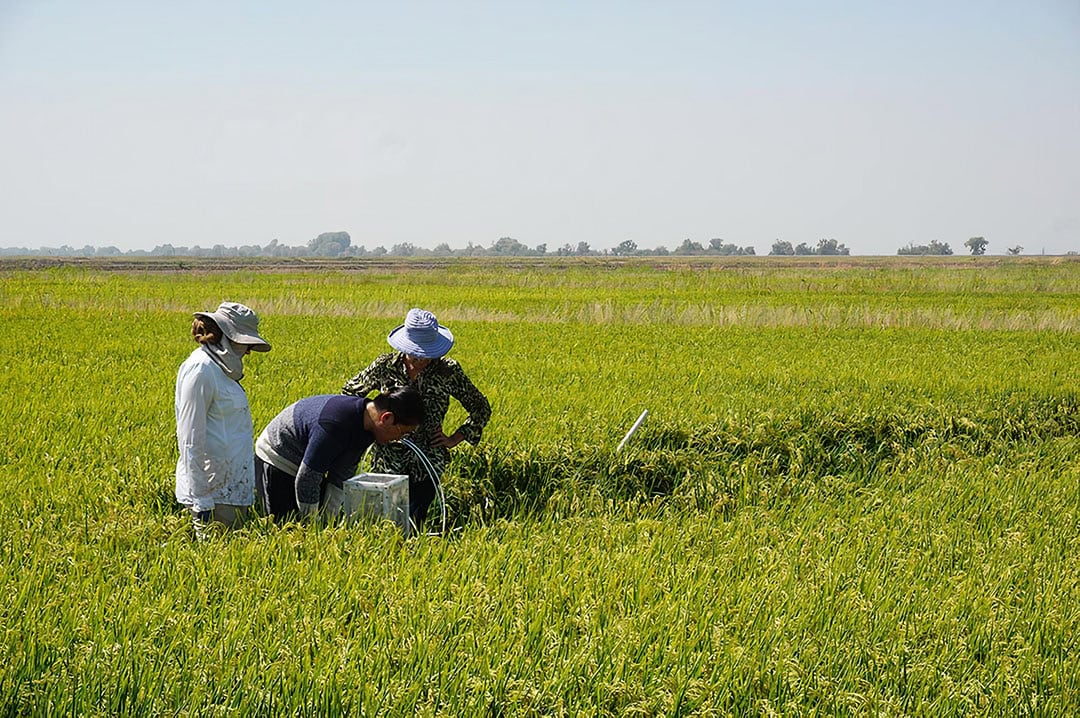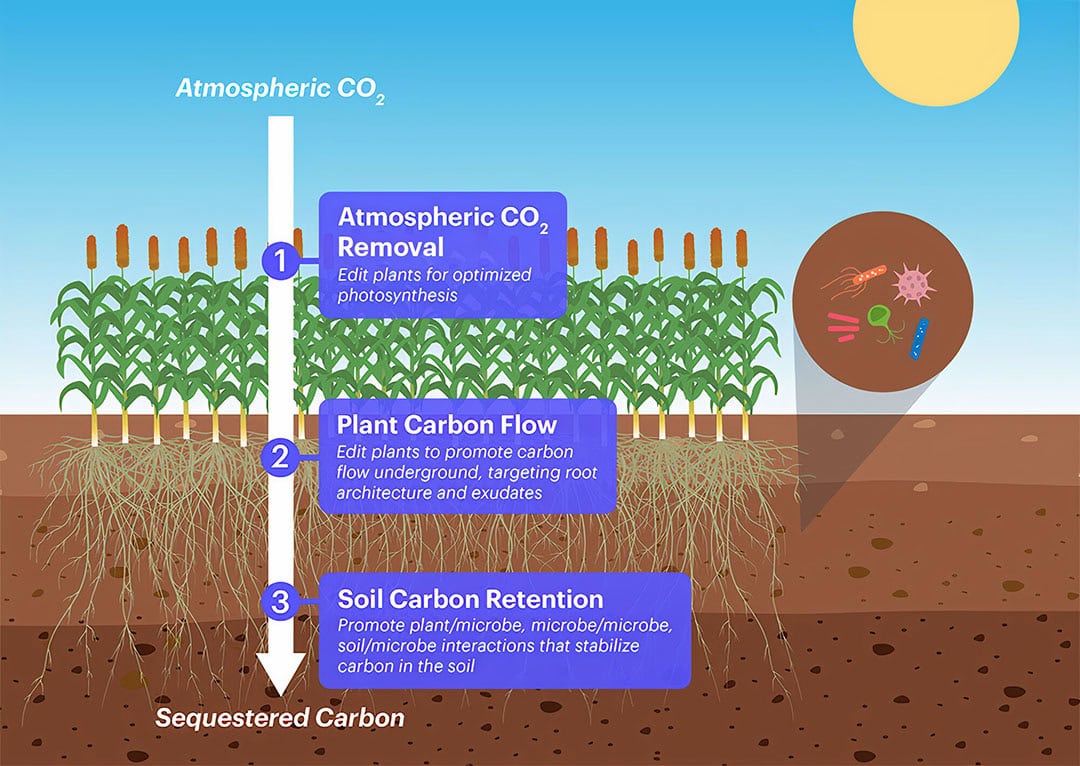Technologies for soil carbon sequestration that also remove greenhouse gases

Worldwide, researchers are working on new ways to increase the capacity of soil carbon sequestration in agriculture. Thanks to various technologies, practical applications are within reach. And they can also significantly reduce our greenhouse gas levels.
The benefits of soil carbon sequestration are well-known. It improves soil fertility, reduces erosion and increases resilience to droughts and floods. With the introduction of carbon credits, it can potentially offer growers an extra revenue stream.
Australian company Loam Bio in Orange, New South Wales, inoculates crops with symbiotic microbial fungi that boost the plant’s ability to sequester carbon in the soil they grow in. Loam’s method of delivery is via seed coating, common and simple agricultural practice which makes the technology easily accessible to farmers.
Soil carbon sequestration ability improved
The new technology of Loam Bio has important advantages. As the seed germinates, the microbes improve the ability of the soil around the root system to store carbon. This is achieved by binding the carbon, which is drawn down by the plant during photosynthesis, with microaggregates within the soil.
The microbes have beneficial secondary effects, too – improving the host plant’s fertility and natural protection against disease, and thereby increasing crop yields, according to Loam.
Cheap, long-term, and scalable
Co-founder and CEO Guy Hudson says Loam Bio’s technology is cheap, long-term, and scalable. “Using our naturally-derived products on crops across the globe will give the world the time it needs to adjust to a low-carbon economy. The entire annual US aviation emissions could be removed if our seed coating was applied to America’s soybean crop.”
Loam Bio recently announced that work is underway with agribusiness GrainCorp to assist Australian growers in building and monetising carbon in their soil. The companies are developing a program that pairs GrainCorp’s grower customers with Loam Bio’s soil carbon inoculum technology, to increase the amount of carbon stored in agricultural soil.
A smooth pathway to build soil carbon
Co-Founder and CPO of Loam Bio Tegan Nock says the goal is for growers to become active in the carbon market, while increasing productivity and driving better soil health and resilience. “Working with GrainCorp will help us to ensure a smooth pathway for growers to build their soil carbon and access the carbon market. This season, we are working with growers to plant barley and canola crops that have been inoculated with our novel soil carbon fixing technology, across 1,500 hectares in New South Wales and Victoria.”
In the US, a new study by Texas A&M AgriLife Research scientists has found that bioenergy sorghum hybrids capture and sequester significant amounts of atmospheric carbon dioxide in soil. The crop can improve soil fertility and potentially earn carbon credits to offset greenhouse gas emissions.
Text continues below image

Improving sorghum varieties
The researchers have been working to improve bioenergy sorghum varieties to produce the ideal annual bioenergy crop. The team uses a combination of genetic, genomic, and biochemical approaches to generate knowledge that will enable the design of next-generation climate-resilient bioenergy crops.
The hybrid used in a recent study creates high yields of biomass for fuel, power and bioproduct generation. The crop also has excellent drought resilience, good nitrogen-use efficiency and a deep root system.
One acre planted with a bioenergy sorghum hybrid accumulates about 3.1 tons of dry root biomass over the crop’s 155-day growing season. In addition, the study shows that bioenergy sorghum’s unusually deep root system can reach sources of water and nutrients untapped by other annual crops. Bioenergy sorghum roots grew to over 6.5 feet deep over their growing season.
The new metrics make it easier to predict how much atmospheric carbon dioxide might be captured inside roots. The numbers can also shed light on how many carbon credits a planted field might earn. The numbers are also important for understanding the crop’s potential to improve soil fertility and water-holding capacity by replenishing soil organic carbon.
The Innovative Genomics Institute (IGI), a research group in Berkeley, California, founded by CRISPR co-inventor Jennifer Doudna, has recently announced a program to use the revolutionary gene-editing tool on plants to boost their aptitude for carbon storage. The initial program will last three years and is focusing on agricultural crops.
Text continues below image

CRISPR genome editing to enhance soil carbon sequestration
The research team seeks to use CRISPR genome editing to enhance the natural ability of plants and soil microbes to both capture and store carbon from the atmosphere. Dr. Priscilla Chan: “This technology has the potential to supercharge the natural abilities of plants, enabling them to pull more carbon out of the atmosphere and store more carbon in their roots and the surrounding soil.”
One group will focus on editing rice varieties for improved photosynthesis to remove carbon from the atmosphere more efficiently, and optimizing both root development and root exudates that can promote carbon sequestration in the soil. A second group is developing new high-efficiency genome editing protocols for sorghum.
Widespread adoption
A third group will develop techniques to trace carbon fixed by the improved cultivars, and study the soil microbial communities that actively promote long-term carbon storage. Real-world impact will require widespread adoption of the outputs of this work, so alongside the scientific efforts, Melinda Kliegman, Public Impact Director at the IGI, will develop a deployment plan and work to ensure that the developments from this work meet the needs of end users.
The team estimates that by increasing sorghum photosynthetic carbon capture and expanding cropping into marginal lands, it may be possible to achieve a net increase of up to 1.4 billion metric tons of CO2 equivalent captured annually worldwide, half of which could be stored in a long-lived form when combined with biomass conversion technologies. The IGI team’s advances can be extended in the future as this work is applied to other crops, such as wheat and corn.
Reinventing photosynthesis
And in Germany, researcher Tobias Erb of the Max Planck Society leads a large team looking for ways to improve photosynthesis beyond its natural limits. Plants generally use only about 1 percent of the sunlight that falls on them to make carbohydrates, consuming or fixing atmospheric carbon in the process.
Erb and his colleagues are on track radically to reinvent photosynthesis using synthetic biology, enzyme engineering and machine learning to create innovative crops featuring a new-to-nature CO2-fixation metabolism with photosynthetic yields increased by 20 percent to 60 percent (potentially up to 200 percent).
Text continues below image

They have already demonstrated several synthetic pathways for improved CO2 fixation that are up to 20 times faster than natural photosynthesis and require 20 percent less energy in the lab. The research team is working to implement these new-to-nature solutions in microorganisms and plants to improve their CO2 uptake efficiency beyond the limits set by natural evolution. Models suggest that their approach could lead to the ability to sequester upwards of 3 Gigatonne of CO2 equivalent annually, if applied to crops alone.
Text continues below box
Nanotechnology to improve soil carbon sequestration
In the future, nanotechnology could also be useful in trapping carbon. Nanomaterials, due to their unique properties at nanoscale, are reported to enhance carbon stabilisation and its possible sequestration in soil.
Also read: Nanotechnology to drastically reduce use of weed control chemicals
However, contradictory reports on the potential impact of nanomaterials on soil micro-organisms so far limit the adoption of this technology at large scale. More and continuous efforts are needed to explore the possibility of nanotechnology in carbon sequestration.
Studies on the usefulness of nanomaterial and nanotechnology in soil organic carbon (SOC) sequestration with special emphasis on soil aggregation are scarce, according to researchers of the Erbo Auburn University in the US and the Indian Agricultural Research Institute. Further research efforts are needed to establish the intense potentiality of natural as well as engineered nanoparticles in SOC stabilisation and sequestration.
There is a lack of information on the transformation of nanomaterials and their fates in soil. Besides, the solution chemistry of metallic nanomaterials is quite limited, and thermodynamic data such as solubility and reaction constants of these materials are unavailable.
Limited information is also available on the physicochemical interactions between nanomaterials and bacterial cell surfaces. Further studies are required to standardise the optimum dosage of nanoparticle application in soil in order to avoid potential damage to the terrestrial ecosystem. Economic evaluation and cost-effectiveness of nanoparticles for possible application at large scale need to be addressed in future studies.



